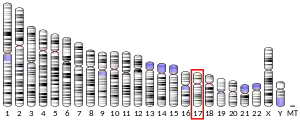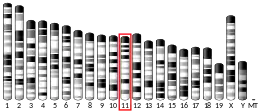PLEKHM1
Pleckstrin homology domain-containing family M member 1 also known as PLEKHM1 is a protein that in humans is encoded by the PLEKHM1 gene.[5][6]
Function
PLEKHM1 may have critical function in vesicular transport in osteoclasts.[7]
Clinical significance
Mutations in the PLEKHM1 gene are associated with osteopetrosis OPTB6.[7]
References
- ENSG00000225190, ENSG00000276358 GRCh38: Ensembl release 89: ENSG00000277111, ENSG00000225190, ENSG00000276358 - Ensembl, May 2017
- GRCm38: Ensembl release 89: ENSMUSG00000034247 - Ensembl, May 2017
- "Human PubMed Reference:". National Center for Biotechnology Information, U.S. National Library of Medicine.
- "Mouse PubMed Reference:". National Center for Biotechnology Information, U.S. National Library of Medicine.
- Nagase T, Ishikawa K, Nakajima D, Ohira M, Seki N, Miyajima N, Tanaka A, Kotani H, Nomura N, Ohara O (April 1997). "Prediction of the coding sequences of unidentified human genes. VII. The complete sequences of 100 new cDNA clones from brain which can code for large proteins in vitro". DNA Res. 4 (2): 141–50. doi:10.1093/dnares/4.2.141. PMID 9205841.
- Hartel-Schenk S, Gratchev A, Hanski ML, Ogorek D, Trendelenburg G, Hummel M, Höpfner M, Scherübl H, Zeitz M, Hanski C (2001). "Novel adapter protein AP162 connects a sialyl-Le(x)-positive mucin with an apoptotic signal transduction pathway" (PDF). Glycoconj. J. 18 (11–12): 915–23. doi:10.1023/A:1022256610674. PMID 12820725. S2CID 6993267.
- van Wesenbeeck L, Odgren PR, Mackay CA, Van Hul W (February 2004). "Localization of the gene causing the osteopetrotic phenotype in the incisors absent (ia) rat on chromosome 10q32.1". J. Bone Miner. Res. 19 (2): 183–9. doi:10.1359/jbmr.2004.19.2.183. PMID 14969387. S2CID 22195601.
Further reading
- Stelzl U, Worm U, Lalowski M, et al. (2005). "A human protein-protein interaction network: a resource for annotating the proteome". Cell. 122 (6): 957–68. doi:10.1016/j.cell.2005.08.029. hdl:11858/00-001M-0000-0010-8592-0. PMID 16169070. S2CID 8235923.
- Hartel-Schenk S, Gratchev A, Hanski ML, et al. (2001). "Novel adapter protein AP162 connects a sialyl-Le(x)-positive mucin with an apoptotic signal transduction pathway". Glycoconj. J. 18 (11–12): 915–23. doi:10.1023/A:1022256610674. PMID 12820725. S2CID 6993267.
- Del Fattore A, Fornari R, Van Wesenbeeck L, et al. (2008). "A new heterozygous mutation (R714C) of the osteopetrosis gene, pleckstrin homolog domain containing family M (with run domain) member 1 (PLEKHM1), impairs vesicular acidification and increases TRACP secretion in osteoclasts". J. Bone Miner. Res. 23 (3): 380–91. doi:10.1359/jbmr.071107. PMID 17997709. S2CID 34037255.
- Edwards TL, Scott WK, Almonte C, et al. (2010). "Genome-Wide Association Study Confirms SNPs in SNCA and the MAPT Region as Common Risk Factors for Parkinson Disease". Annals of Human Genetics. 74 (2): 97–109. doi:10.1111/j.1469-1809.2009.00560.x. PMC 2853717. PMID 20070850.
- Kimura K, Wakamatsu A, Suzuki Y, et al. (2006). "Diversification of transcriptional modulation: large-scale identification and characterization of putative alternative promoters of human genes". Genome Res. 16 (1): 55–65. doi:10.1101/gr.4039406. PMC 1356129. PMID 16344560.
- Strausberg RL, Feingold EA, Grouse LH, et al. (2002). "Generation and initial analysis of more than 15,000 full-length human and mouse cDNA sequences". Proc. Natl. Acad. Sci. U.S.A. 99 (26): 16899–903. doi:10.1073/pnas.242603899. PMC 139241. PMID 12477932.
- Van Wesenbeeck L, Odgren PR, Coxon FP, et al. (2007). "Involvement of PLEKHM1 in osteoclastic vesicular transport and osteopetrosis in incisors absent rats and humans". J. Clin. Invest. 117 (4): 919–30. doi:10.1172/JCI30328. PMC 1838941. PMID 17404618.
This article is issued from Wikipedia. The text is licensed under Creative Commons - Attribution - Sharealike. Additional terms may apply for the media files.



